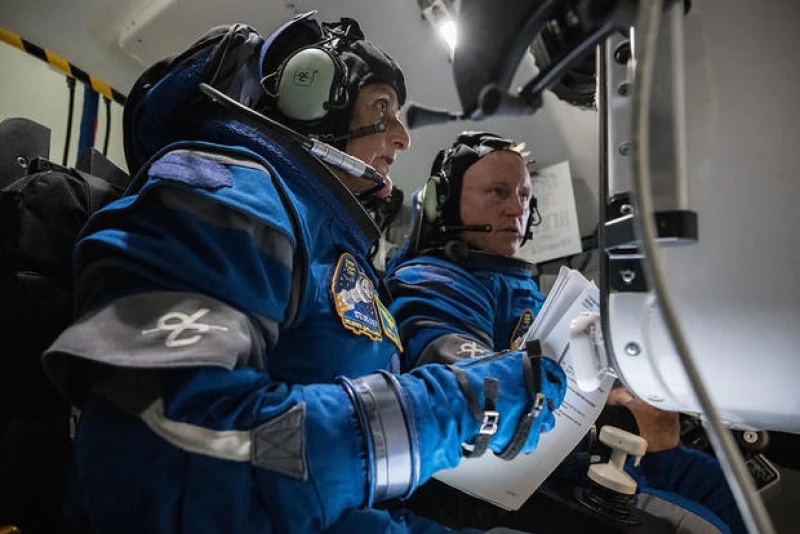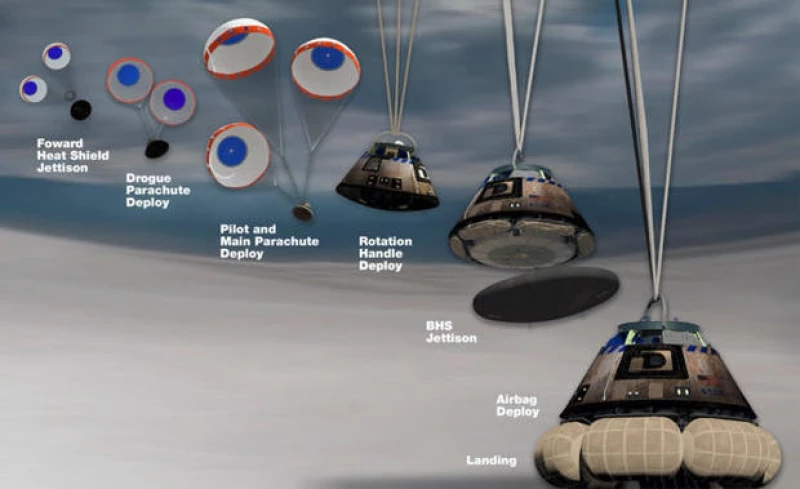Years behind schedule and more than a billion dollars over budget, Boeing's Starliner capsule is finally poised for its first piloted launch Monday, a critical test flight carrying two veteran astronauts to the International Space Station and in so doing, demonstrate an alternative to SpaceX's already operational Crew Dragon.
While SpaceX has launched 50 astronauts, cosmonauts and civilians into orbit in 13 piloted Crew Dragon flights since May 2020, Boeing has been bedeviled by multiple technical problems that required extensive re-work -- and an additional unpiloted test flight -- to resolve.
But mission managers say all the known issues have been corrected, multiple other upgrades and improvements have been implemented and the spacecraft has been thoroughly tested to verify it is finally ready to safely carry astronauts to and from the space station.

No one is more eager for launch than the Starliner's crew, both active-duty NASA astronauts.
"I have full confidence in the management that makes the decisions that filter down to the operations team, full confidence on the NASA side and the Boeing side," said mission commander Barry "Butch" Wilmore. "There have been some issues in the past. That's the past. That is not now."
Co-pilot Sunita Williams agreed, adding "We have absorbed many valuable lessons and implemented them into our preparations. We would not declare ourselves ready if we were not fully prepared."
The Starliner is set to launch atop a United Launch Alliance Atlas 5 rocket from the Cape Canaveral Space Force Station at 10:34 p.m. EDT on Monday, precisely when launch complex 41 aligns with the space station's orbit due to Earth's rotation.
Wilmore and Williams are ideal candidates to pilot the Starliner on its inaugural test flight. Both are former Navy test pilots and highly experienced astronauts, boasting four space flights, 11 spacewalks, and a total of 500 days in orbit. They have previous spaceflight experience on the space shuttle and Russia's Soyuz crew ferry ship.
Now, they are embarking on a new journey by piloting a spacecraft on its maiden crewed mission.
"I recall the moment I was selected for Test Pilot School and wondering if I would ever be the first to achieve something in an aircraft that has never been done before," Wilmore, a former F/A-18 carrier pilot, Desert Storm veteran, and pastor, shared with CBS News. "I could never have imagined that I would be part of the crew for the inaugural flight of a spacecraft. And yet, here we are."
Exciting Milestone: First Manned Starliner Flight to Launch with Atlas Rocket
Marking a significant milestone, the upcoming piloted flight of the Starliner will also be historic as it will be the first time astronauts are launched using an Atlas rocket since Gordon Cooper's final Mercury flight over 60 years ago.
Despite the numerous Atlas rocket launches over the years, the latest-generation Atlas 5 stands out with its Russian-built RD-180 first-stage engine. This version is "human rated" once again, featuring high-reliability components and an advanced emergency fault detection system that can trigger a safe escape in the face of a potential launch failure.
Reflecting on the upcoming launch, Williams shared, "We've both been to a couple of launches. One of them was an Air Force payload. I found out the price tag on that payload, and I was like, OK, if they're launching that on that Atlas 5, I feel very comfortable sitting on (an) Atlas 5! It's a great rocket."
In case of any unexpected issues during the Atlas 5's flight, the Starliner, like SpaceX's Crew Dragon, is equipped with powerful abort motors that can propel the capsule away from the booster at any point from the launch pad to orbit. Following an abort, the capsule would make a parachute-assisted splashdown in the Atlantic Ocean off the East Coast of the United States.
While the system is designed to be fully automatic, Wilmore and Williams have the capability to manually trigger an abort if needed. Additionally, the spacecraft includes two independent systems that provide the pilots with computer-assisted and direct manual control in the event of significant guidance, navigation, or computer challenges during launch or while in orbit.

The Starliner Crew Flight Test: A Milestone for NASA
With the Starliner flight, NASA embarks on only the sixth occasion of putting astronauts on board a new spacecraft for the first time. Jim Free, NASA's associate administrator for space operations, emphasized the significance of the Starliner Crew Flight test (CFT) as "an absolutely critical milestone."
"The lives of our crew members, Suni Williams and Butch Wilmore, are at stake," he stated. "Let me just remind everybody again, this is a new spacecraft. I'll also remind you this is a test flight. ... We certainly have some unknowns in this mission, we may encounter things we don't expect. But our job now is to remain vigilant and keep looking for issues."
While expressing confidence in the readiness of the Starliner for the flight, Free tempered expectations by highlighting the importance of completing a successful mission first. He mentioned the future redundancy in ISS access with the certification of Starliner alongside another human space transportation system in the United States.
If the launch proceeds smoothly, the Starliner is expected to reach its initial orbit in about 15 minutes. The flight plan involves Wilmore and Williams overseeing an automated rendezvous with the space station, with opportunities for manual control to test the crew's ability to adjust trajectory or respond to emergencies.
Approaching the station from behind and below, the astronauts will catch up with the lab complex early Wednesday, docking at the station's forward port at 12:46 a.m. on May 8.
They'll be welcomed aboard by Expedition 71 commander Oleg Kononenko and his Soyuz MS-25 crewmates, Nikolai Chub and NASA's Tracy Dyson, along with NASA Crew 8 commander Matthew Dominick, Michael Barratt, Jeanette Epps and cosmonaut Alexander Grebenkin.
Wilmore and Williams plan to spend a little more than a week aboard the station, transferring 750 pounds of equipment to the lab, powering down the Starliner, and making sure it can be used as a "safe haven" for visiting long-duration crews. The current plan calls for undocking on May 15, but that could change depending on the weather at the landing site.

Unlike SpaceX's Crew Dragon, which splashes down in the ocean at the end of a mission, the Starliner is designed to touch down on land, using parachutes and two sets of sequentially inflating airbags to ease the shock of touchdown. For the Crew Flight Test, a May 15 undocking would target landing at White Sands Space Harbor in New Mexico.
But given this is a test flight, NASA will not approve undocking unless winds at the landing site are 6 knots or less. The limit for the actual landing is 10 knots. As a result, NASA may replan for a night landing, when desert winds typically die down, at a different site.
Assuming the flight goes well, NASA managers hope to certify the Starliner for operational crew ferry missions starting next year, launching one Crew Dragon and one Starliner each year to change out space station crew through the program's retirement at the end of the decade.
Commercial crew program marks major shift in human spaceflight
In the wake of the space shuttle's retirement, NASA awarded two Commercial Crew Program contracts in 2014, one to SpaceX valued at $2.6 billion and the other to Boeing for $4.2 billion, to spur the development of independent spacecraft capable of carrying astronauts to and from the International Space Station.
The goal was to end NASA's post-shuttle reliance on Russia's Soyuz and to resume launching American astronauts from U.S. soil aboard American rockets and spacecraft. Equally important to NASA: having two independent spacecraft for crew flights to the ISS in case one company's ferry ship runs into problems that might ground it for an extended period.
The original target date for initial piloted CCP flights was 2017. Funding shortfalls in Congress and technical snags delayed development, including an explosion during a ground test that destroyed a SpaceX Crew Dragon.
But the California rocket builder still managed to kick off piloted flights in May 2020, successfully launching two NASA astronauts on a Crew Dragon test flight to the space station.
Since then, SpaceX has launched eight operational crew rotation flights to the station, three research missions to the lab funded by Houston-based Axiom Space and a purely commercial, two-man, two-woman trip to low-Earth orbit paid for by billionaire pilot and businessman Jared Isaacman. In all, 50 people have flown to orbit aboard Crew Dragons.

It's been a different story for Boeing's Starliner.
During an initial unpiloted test flight in December 2019, unexpected software and communications glitches prevented a planned rendezvous with the space station. Boeing corrected those problems and opted to carry out a second uncrewed test flight, at its own expense.
But during the second countdown, engineers ran into problems with stuck propulsion system valves in the Starliner's service module. Engineers eventually traced the problem to moisture intrusion and corrosion, triggering another lengthy delay.
The second Starliner test flight in May 2022 was a success, docking at the space station as planned and returning to Earth with a pinpoint landing. But in the wake of the flight, engineers discovered fresh problems: trouble with parachute harness connectors and concern about protective tape wrapped around wiring that could catch fire in a short circuit.
Boeing faced challenges that delayed the first crewed flight to this year. The company spent over $1 billion to cover the cost of an additional test flight and necessary corrective actions.
Boeing's Crucial Mission
The Crew Flight Test (CFT) launch is a pivotal moment for Boeing, especially in the wake of the 737 Max crashes in 2018 and 2019, along with a recent incident involving a cabin door "plug" on an Alaska Airlines flight that has raised safety concerns.
Despite Boeing's aircraft troubles, Wilmore, a key figure in the mission, emphasized the significance of the Starliner launch in the realm of human spaceflight.
"I don't think it has necessarily anything to do with Boeing and a flight going off," he expressed. "They're all vitally important. This is human spaceflight. That adage you've heard since Apollo 13, failure is not an option? That has nothing specifically to do with Boeing or this program. That's all the things that we do in human spaceflight."
"So, this one is no more or less important than anything else we're doing," Wilmore added. "It just happens to be the most important one we're doing right now."
Williams, another key individual involved, acknowledged the challenges faced in getting the Starliner ready for launch. "I'm not going to say it's been easy. It's a little bit of (an) emotional roller coaster."
The spacecraft has successfully reached its destination
Upon reaching its destination, the spacecraft's mission control expressed their excitement and relief. "We knew we would get here eventually. It's a solid spacecraft. I don't think I would really want to be in any other place right now," said one of the team members.







